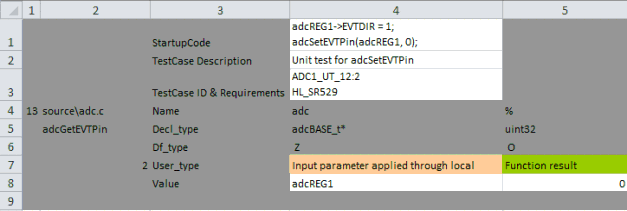SPNU633 January 2020 RM42L432 , RM44L520 , RM44L920 , RM46L430 , RM46L440 , RM46L450 , RM46L830 , RM46L840 , RM46L850 , RM46L852 , RM48L530 , RM48L540 , RM48L730 , RM48L740 , RM48L940 , RM48L950 , RM48L952 , RM57L843 , TMS570LC4357 , TMS570LC4357-EP , TMS570LC4357-SEP , TMS570LS0332 , TMS570LS0432 , TMS570LS0714 , TMS570LS0714-S , TMS570LS0914 , TMS570LS1114 , TMS570LS1115 , TMS570LS1224 , TMS570LS1225 , TMS570LS1227 , TMS570LS2124 , TMS570LS2125 , TMS570LS2134 , TMS570LS2135 , TMS570LS3134 , TMS570LS3135 , TMS570LS3137 , TMS570LS3137-EP
-
HALCoGen-CSP Without LDRA
- Trademarks
- 1 Introduction
- 2 Software Requirements
- 3 HALCoGen TAU Tool Restrictions
- 4 HALCoGen CSP Contents
- 5 Terminologies Used in HALCoGen TAU
- 6 Functional Blocks of HALCoGen TAU
- 7 HALCoGen TAU Test Flow
- 8 How to Use HALCoGen TAU? A Walkthrough
- 9 Inputs to HALCoGen TAU
- 10 How to Add Your Test Cases?
- 11 Reports
- 12
FAQ
- 12.1 Why Does the Application Show “Code Generation Failed"?
- 12.2 Why Does the TCF Generation Fail?
- 12.3 What are the Possible Reasons for Build Failure?
- 12.4 From Where Do I See the Instrumented Code?
- 12.5 Is the Source Code Backed Up Before LDRA Instruments the Code During TAU Execution?
- 12.6 How do I Include a Folder or a Library in my Project?
- 12.7 Is the Tool Compatible Only With HALCoGen v04.02.00? Can I Test a Project Generated With an Older Version?
- 12.8 Why are the Functional Tests Disabled by Default?
- 12.9 How Do I Know Which Functional Tests are Applicable for my Configuration?
- 12.10 Does the Tool Optimize the HALCoGen Code While Compiling?
- 12.11 It Says Test Execution Completed. But I Cannot Find the Report in the Reports Folder.
- 12.12 Test Execution Hung, What to Do? What is the Reason?
- 12.13 Can I Use HALCoGen TAU to Test Source File Other Than HALCoGen Generated Files?
- 12.14 I Have Full Version of LDRA Tool Suite Instead of LDRAUnit. Can I Use This Tool With This License?
- 12.15 How to Get LDRA Unit and Setting up the License After Downloading HALCoGen-CSP From TI?
5.3 What is a Test Sequence?
A test sequence is a set of test cases, unit or functional (not both) targeted on a single or set of c files. A test sequence is written in the form of an Excel sheet listing the following:
- Global Declarations
- Global Code
- Function tested in each test case
- Input parameters for each test case
- Pass or fail criteria for each test case
- Variable declarations, startup code and cleanup code for each test case
In addition, to the traceability report generation, the following artifacts are also added for each test case:
- Test case ID
- Requirements covered by the test case
Each test sequence is converted to a TCF file, which is the actual input to LDRA unit. Figure 1 shows an example of a test case in the test sequence. Click here to see how to add your own test cases.
 Figure 1. Excel Test Case Snapshot
Figure 1. Excel Test Case Snapshot Each test case executes in the following sequence:
- Runs any initialization code
- Configures I/O variables
- Invokes a single function with specified arguments
- Captures any return values that are to be checked
- Captures the value of any I/O variables, ... that are to be checked
- Runs any custom checks, such as checking execution time
- Saves the results
- Runs any cleanup code